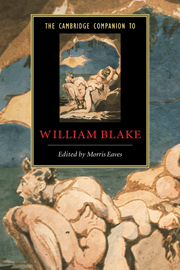Book contents
- Frontmatter
- 1 Introduction
- Part I Perspectives
- Part II Blake's works
- 10 Blake's early works
- 11 From America to The Four Zoas
- 12 Milton and its contexts
- 13 Jerusalem and Blake's final works
- A glossary of terms, names and concepts in Blake
- Guide to further reading
- Seeing Blake's art in person
- Index
- Series List
10 - Blake's early works
from Part II - Blake's works
Published online by Cambridge University Press: 28 May 2006
- Frontmatter
- 1 Introduction
- Part I Perspectives
- Part II Blake's works
- 10 Blake's early works
- 11 From America to The Four Zoas
- 12 Milton and its contexts
- 13 Jerusalem and Blake's final works
- A glossary of terms, names and concepts in Blake
- Guide to further reading
- Seeing Blake's art in person
- Index
- Series List
Summary
“If a method of Printing which combines the Painter and the Poet is a phenomenon worthy of public attention, provided that it exceeds in elegance all former methods, the Author is sure of his reward,” especially when the resulting productions are “of equal magnitude and consequence” with those “of any age or country” (E 692). So maintained thirty-five-year-old William Blake in an etched prospectus addressed “To the Public” and dated 10 October 1793, two weeks before the execution of Marie Antoinette would dominate the London news. “Works now published and on Sale at Mr. Blake's, No. 13, Hercules Buildings, Lambeth” comprised two “Historical Engraving[s]” - Job and Edward and Elinor - two “small book[s] of engraving” - The Gates of Paradise and The History of England (now lost or never actually published) - and, extending this range of concern with matters national, spiritual, and educational in diverse media: America, a Prophecy; Visions of the Daughters of Albion; The Book of Thel; The Marriage of Heaven and Hell; Songs of Innocence and Songs of Experience. In his only recorded use of the phrase now synonymous with his greatest achievement, Blake described these latter six books as “in Illuminated Printing.” The prices ranged from three to twelve shillings (almost a laborer's weekly wage). Not advertised were the author's two conventionally type-set volumes, Poetical Sketches of ten years before and The French Revolution of 1791; missing also from the prospectus were Blake's five-year-old first experiments in illuminated printing, All Religions are One and There is No Natural Religion and, understandably, two manuscripts: a burlesque set in an island in the moon and a verse narrative about a mythic patriarch, Tiriel. None of the works he then advertised, which include those best known today, were to find a large market, but Blake later commented that sales were “sufficient to have gained me great reputation as an Artist which was the chief thing Intended” (letter of 9 June 1818, E 771).
- Type
- Chapter
- Information
- The Cambridge Companion to William Blake , pp. 191 - 209Publisher: Cambridge University PressPrint publication year: 2003
- 2
- Cited by



